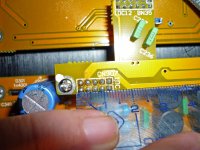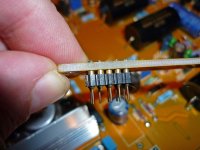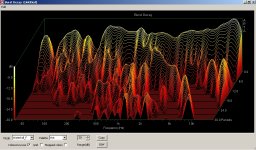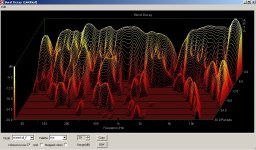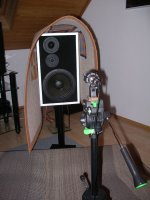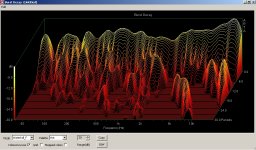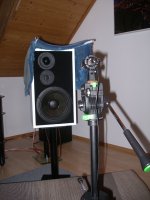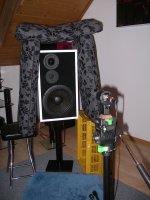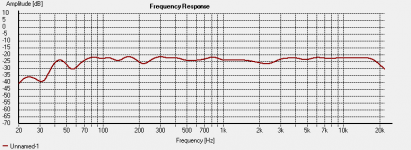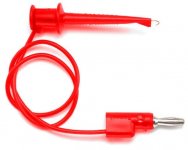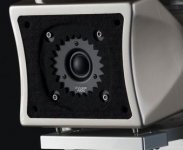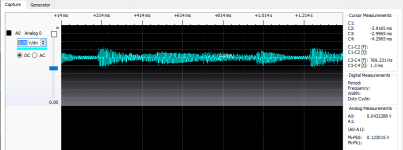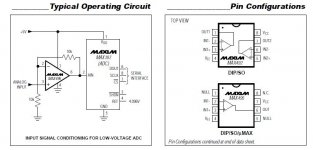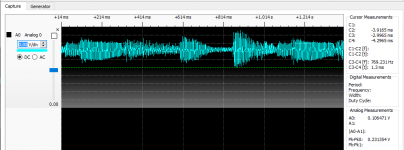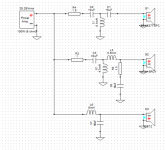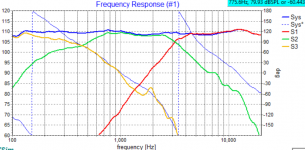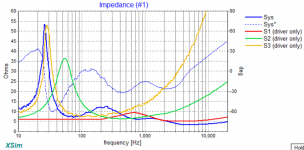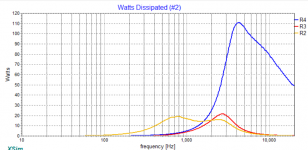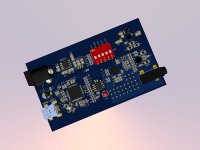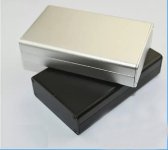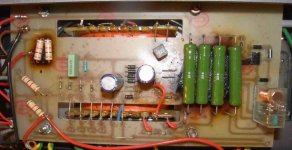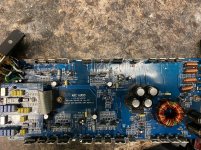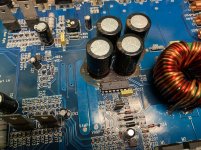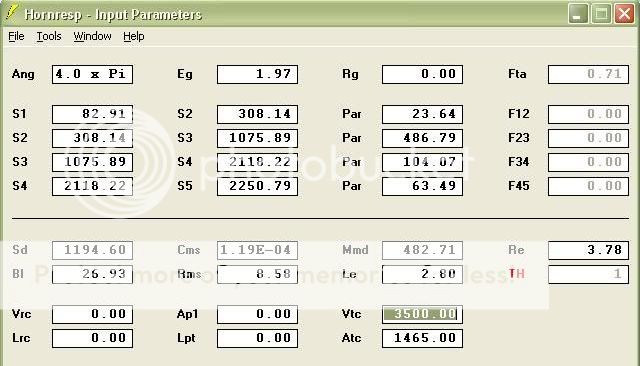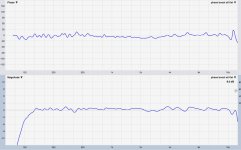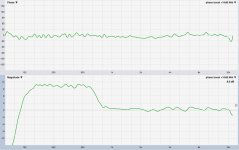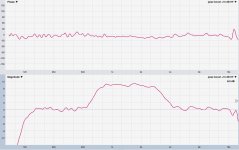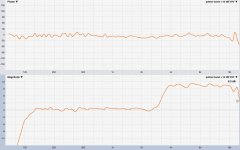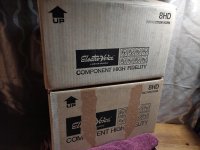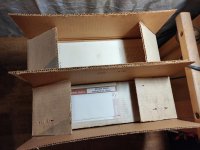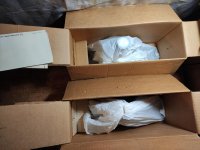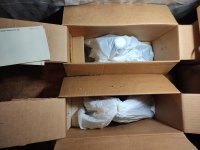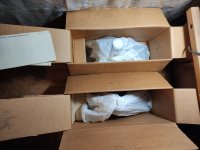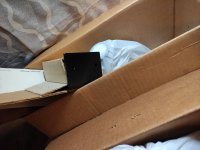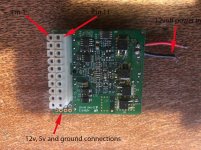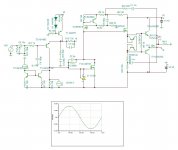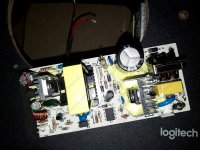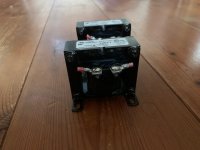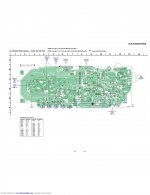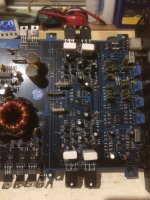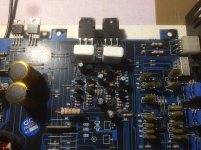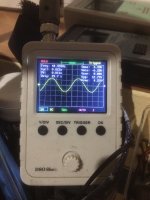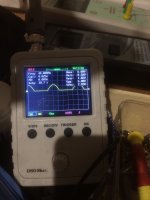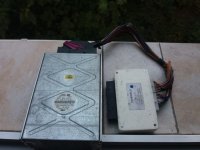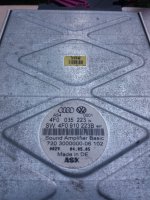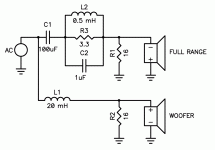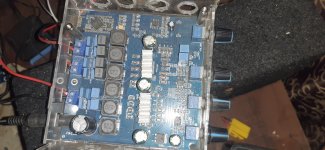I have been working on a couple of tapped bass horn designs for many months now. This design is centered around a large 45x45x24" cabinet form and a single LMS Ultra 5400 driver. The weight with the 80lb driver loaded in is probably near 300lbs. The cabs are built from 18mm and 12mm BB and put together with PL premium construction adhesive and pocket screws. The drivers and access panel mount with 1/4x20 screws and threaded inserts. The finish is Duratex. A gallon and a half on each cab. The access panel is purposely large enough to allow for even 21" drivers. Other 18" or 21" drivers may be useable in this cab.
I did all of the simulating in HR but quickly jumped to Akabak after realizing that the process worked better designing the physical cabinet and horn fold first and then translating that into Akabak script instead of trying to optimize some simulation and then realizing that it would not fit into the cabinet, was too big, ended up with dead spaces in the cab, or otherwise had problems with real world buildability. This was a many month wash, rinse, repeat process of refinement. Once I got a fold layout that actually fit in the cab confines it was a manor of much tweaking to try and improve it with what was available. When I was happy with the compromises and that I would not get it any better I was lucky enough to have a friend offer to build the cabs at his cost at his professional cabinet shop. That took about 2 or 3 months. I had originally planned to build them myself but to be completely honest I am so glad that I didn't have to. I wouldn't have gotten them done near as quickly or with the same quality. Additionally these cabs were sort of a risk. There was no prototype and with something this large it would be easy to make mistakes and screw something up either in the build or while simulating. It wouldn't take much for it to be just and expensive and time consuming pile of scrap wood. There is also some concern over whether the driver will withstand the pressures in the horn, whether this driver is suited to a TH and about the effect that the folding will have on things. The fold of the horn is not elegant by any means. It has a number of 90 deg turns and many relatively short sections. I tried for weeks to come up with a fold to fit in this cabinet size with the right length and this is what I could get to work. It has compromises. We will see how bad they turn out to be. I tried to model the cabinet being built as accurately as possible but you can't get everything.
My inspiration for these was the Danley Th50 which I was quite impressed by when I heard it and the DTS-10 of which I own a pair of and happen to have been lucky enough to have had a very small hand in its development through correspondance with Tom. The goal is for something to use in LARGE open spaces and big rooms without a lot of gain and longer than normal listening distances. The goal was to cover 16-100hz well in a cab that wasn't too gigantic which is how I ended up at a size similar to a Labsub but slightly wider. That form fits almost perfectly into the space that I have available for the pair also. The effective lower limit on these according to the simulation should be just below 15hz at full power input. These should be safe from over excursion with 130v peaks anywhere above 14.5hz. I am going to use this pair as the anchor in my system at a warehouse space which is about 10,000cu ft and really lossy. There is not much room gain there to speak of until the really low freq's. I figure that 4 of these could rock a large commercial sized movie theater very well. That was really sort of the idea with this was, what would be suitable to cover 15-80hz for an Imax? So to answer the question it is something designed for my purposes and was never really meant to be a ht or music sub in someone's living room, being quite gigantic, heavy and rather overkill. A pair would be devastating in a typical domestic sized room or house. It is also not really suited to typical live sound or mobile SR as it has extension an octave lower than needed. Might be good for some high power dubstep or DnB though.
Anyway here is a rough HornResponse approximation of the Akabak script.
Here is the Akabak script. I ran out of sections. 
|COMMENT:LMS5400 ULTRA 18hz 45x45x24 TH 020411 FINAL, no dead space, straight throat, with constriction, big mouth(LMS obstructs roughly 613cm2)
|=========================================================== =============================================
|REQUIRED AKABAK SETTINGS:
|File > Preferences > Physical system constants:
|Sound velocity c = 344m/s
|Medium density rho = 1.205kg/m3
|Sum > Acoustic power:
|Frequency range = 10Hz to 20kHz
|Points = 533
|Input voltage = 1.97V rms
|Integration = 2Pi-sr
|Integration steps = 1 degree ... 1 degree
|Integration method = Cross
|=========================================================== =============================================
Def_Const |Input Parameter Values
{
|Length, area and volume values converted to metres, square metres and cubic metres:
S1 = 82.90855e-4; |Horn segment 1 throat area (sq cm)
S2 = 308.14365e-4; |Horn segment 1 mouth area and horn segment 2 throat area (sq cm)
S3 = 453.98375e-4; |Horn segment 2 mouth area and horn segment 3 throat area (sq cm)
S4 = 226.85056e-4; |Horn segment 3 mouth area and horn segment 4 throat area (sq cm)/ brace area
S5 = 249.88796e-4; |Horn segment 4 mouth area and horn segment 5 throat area (sq cm)/ brace area
S6 = 513.6456e-4; |Horn segment 5 mouth area and horn segment 6 throat area (sq cm)
S7 = 729.21504e-4; |Horn segment 6 mouth area and horn segment 7 throat area (sq cm)
S8 = 517.6522e-4; |Horn segment 7 mouth area and horn segment 8 throat area (sq cm)
S9 = 254.60955e-4; |Horn segment 8 mouth area and horn segment 9 throat area (sq cm)/ brace area
S10 = 278.2318e-4; |Horn segment 9 mouth area and horn segment 10 throat area (sq cm)/ brace area
S11 = 570.7141e-4; |Horn segment 10 mouth area and horn segment 11 throat area (sq cm)
S12 = 846.68843e-4; |Horn segment 11 mouth area and horn segment 12 throat area (sq cm)
S13 = 579.57232e-4; |Horn segment 12 mouth area and horn segment 13 throat area (sq cm)
S14 = 795.34572e-4; |Horn segment 13 mouth area and horn segment 14 throat area (sq cm)
S15 = 587.76034e-4; |Horn segment 14 mouth area and horn segment 15 throat area (sq cm)
S16 = 628.4965e-4; |Horn segment 15 mouth area and horn segment 16 throat area (sq cm)
S17 = 894.92785e-4; |Horn segment 16 mouth area and horn segment 17 throat area (sq cm)
S18 = 637.70438e-4; |Horn segment 17 mouth area and horn segment 18 throat area (sq cm)
S19 = 908.89994e-4; |Horn segment 18 mouth area and horn segment 19 throat area (sq cm)
S20 = 647.05796e-4; |Horn segment 19 mouth area and horn segment 20 throat area (sq cm)
S21 = 684.16633e-4; |Horn segment 20 mouth area and horn segment 21 throat area (sq cm)
S22 = 1014.9946e-4; |Horn segment 21 mouth area and horn segment 22 throat area (sq cm)
S23 = 694.67089e-4; |Horn segment 22 mouth area and horn segment 23 throat area (sq cm)
S24 = 955.76983e-4; |Horn segment 23 mouth area and horn segment 24 throat area (sq cm)
S25 = 704.47613e-4; |Horn segment 24 mouth area and horn segment 25 throat area (sq cm)
S26 = 728.39915e-4; |Horn segment 25 mouth area and horn segment 26 throat area (sq cm)
S27 = 1037.1547e-4; |Horn segment 26 mouth area and horn segment 27 throat area (sq cm)
S28 = 739.10769e-4; |Horn segment 27 mouth area and horn segment 28 throat area (sq cm)
S29 = 1019.4091e-4; |Horn segment 28 mouth area and horn segment 29 throat area (sq cm)
S30 = 749.69967e-4; |Horn segment 29 mouth area and horn segment 30 throat area (sq cm)
S31 = 964.5552e-4; |Horn segment 30 mouth area and horn segment 31 throat area (sq cm)
S32 = 1367.7644e-4; |Horn segment 31 mouth area and horn segment 32 throat area (sq cm)
S33 = 989.80404e-4; |Horn segment 32 mouth area and horn segment 33 throat area (sq cm)
S34 = 1038.2765e-4; |Horn segment 33 mouth area and horn segment 34 throat area (sq cm)
S35 = 1428.0236e-4; |Horn segment 34 mouth area and horn segment 35 throat area (sq cm)
S36 = 1058.7029e-4; |Horn segment 35 mouth area and horn segment 36 throat area (sq cm)
S37 = 1060.4949e-4; |Horn segment 36 mouth area and horn segment 37 throat area (sq cm)
S38 = 1509.5979e-4; |Horn segment 37 mouth area and horn segment 38 throat area (sq cm)
S39 = 1075.8948e-4; |Horn segment 38 mouth area and horn segment 39 throat area (sq cm)
S40 = 532.2565e-4; |Horn segment 39 mouth area and horn segment 40 throat area (sq cm)/ brace area
S41 = 682.62005e-4; |Horn segment 40 mouth area and horn segment 41 throat area (sq cm)/ brace area
S42 = 1413.3813e-4; |Horn segment 41 mouth area and horn segment 42 throat area (sq cm)
S43 = 2501.1503e-4; |Horn segment 42 mouth area and horn segment 43 throat area (sq cm)
S44 = 2065.1744e-4; |Horn segment 43 mouth area and horn segment 44 throat area (sq cm)
S45 = 2067.7094e-4; |Horn segment 44 mouth area and horn segment 45 throat area (sq cm)
S46 = 1505.2217e-4; |Horn segment 45 mouth area and horn segment 46 throat area (sq cm)/ (1505.2217 with driver restriction, 2118.2217 without)
S47 = 2167.5538e-4; |Horn segment 46 mouth area and horn segment 47 throat area (sq cm)
S48 = 2237.6765e-4; |Horn segment 47 mouth area and horn segment 48 throat area (sq cm)
S49 = 2611.6741e-4; |Horn segment 48 mouth area (sq cm)
L12 = 23.64486e-2; |Horn segment 1 axial length (cm)
L23 = 54.00802e-2; |Horn segment 2 axial length (cm)
L34 = 8.93572e-2; |Horn segment 3 axial length (cm)brace area
L45 = 47.001684e-2; |Horn segment 4 axial length (cm)
L56 = 3.214878e-2; |Horn segment 5 axial length (cm)
L67 = 3.504946e-2; |Horn segment 6 axial length (cm)
L78 = 3.563112e-2; |Horn segment 7 axial length (cm)
L89 = 2.418334e-2; |Horn segment 8 axial length (cm)brace area
L910 = 48.208438e-2; |Horn segment 9 axial length (cm)
L1011 = 2.373376e-2; |Horn segment 10 axial length (cm)
L1112 = 4.11353e-2; |Horn segment 11 axial length (cm)
L1213 = 4.7655988e-2; |Horn segment 12 axial length (cm)
L1314 = 4.3843448e-2; |Horn segment 13 axial length (cm)
L1415 = 3.827526e-2; |Horn segment 14 axial length (cm)
L1516 = 40.694864e-2; |Horn segment 15 axial length (cm)
L1617 = 4.298442e-2; |Horn segment 16 axial length (cm)
L1718 = 4.9505108e-2; |Horn segment 17 axial length (cm)
L1819 = 4.9652428e-2; |Horn segment 18 axial length (cm)
L1920 = 4.418838e-2; |Horn segment 19 axial length (cm)
L2021 = 37.065458e-2; |Horn segment 20 axial length (cm)
L2122 = 4.912106e-2; |Horn segment 21 axial length (cm)
L2223 = 5.5748428e-2; |Horn segment 22 axial length (cm)
L2324 = 5.1532028e-2; |Horn segment 23 axial length (cm)
L2425 = 4.58724e-2; |Horn segment 24 axial length (cm)
L2526 = 35.401758e-2; |Horn segment 25 axial length (cm)
L2627 = 4.999228e-2; |Horn segment 26 axial length (cm)
L2728 = 5.6479948e-2; |Horn segment 27 axial length (cm)
L2829 = 5.4557168e-2; |Horn segment 28 axial length (cm)
L2930 = 5.119624e-2; |Horn segment 29 axial length (cm)
L3031 = 47.806102e-2; |Horn segment 30 axial length (cm)
L3132 = 6.366002e-2; |Horn segment 31 axial length (cm)
L3233 = 6.6675e-2; |Horn segment 32 axial length (cm)
L3334 = 32.559498e-2; |Horn segment 33 axial length (cm)
L3435 = 6.745478e-2; |Horn segment 34 axial length (cm)
L3536 = 6.860286e-2; |Horn segment 35 axial length (cm)
L3637 = 1.203452e-2; |Horn segment 36 axial length (cm)
L3738 = 7.239254e-2; |Horn segment 37 axial length (cm)
L3839 = 7.780782e-2; |Horn segment 38 axial length (cm)
L3940 = 1.651254e-2; |Horn segment 39 axial length (cm)brace area
L4041 = 51.303936e-2; |Horn segment 40 axial length (cm)
L4142 = 3.48996e-2; |Horn segment 41 axial length (cm)
L4243 = 12.146026e-2; |Horn segment 42 axial length (cm)
L4344 = 10.563352e-2; |Horn segment 43 axial length (cm)
L4445 = 1.200658e-2; |Horn segment 44 axial length (cm)
L4546 = 23.711916e-2; |Horn segment 45 axial length (cm)
L4647 = 23.490936e-2; |Horn segment 46 axial length (cm)
L4748 = 33.151826e-2; |Horn segment 47 axial length (cm)
L4849 = 6.847332e-2; |Horn segment 47 axial length (cm)
Vtc = 3500.00e-6; |Throat chamber volume (cc)
Atc = 1465.00e-4; |Throat chamber cross-sectional area (sq cm)
|Parameter Conversions:
Sd = 1194.60e-4; |Diaphragm area (sq cm)
Ltc = Vtc / Atc;
}
|=========================================================== =============================================
|Network node numbers for this tapped horn system:
| 0-Voltage-1
| |
| -Chamber-5-Driver---
| | |
|8-Segment-9-Segment-10-Segment-11-Segment-12-Segment-13-Segment-14-Segment-15-Segment-16-Segment-17-Segment-18-Segment-19-Segment-20-Segment-21-Segment-22-Segment-23-Segment-24-Segment-25-Segment-26-Segment-27-Segment-28-Segment-29-Segment-30-Segment-31-Segment-32-Segment-33-Segment-34-Segment-35-Segment-36-Segment-37-Segment-38-Segment-39-Segment-40-Segment-41-Segment-42-Segment-43-Segment-44-Segment-45-Segment-46-Segment-47-Segment-48-Segment-49-Segment-50-Segment-51-Segment-52-Segment-53-Segment-54-Segment-55-Segment-56-Radiator
|=========================================================== =============================================
Def_Driver 'Driver'
Sd=1194.60cm2
Bl=26.93Tm
Cms=1.19E-04m/N
Rms=8.58Ns/m
fs=20.5001Hz |Mmd = 482.71g not recognised by AkAbak, fs calculated and used instead
Le=2.80mH
Re=3.78ohm
ExpoLe=1
System 'System'
Driver Def='Driver''Driver'
Node=1=0=5=53
Duct 'Throat chamber'
Node=5=9
SD={Atc}
Len={Ltc}
Visc=0
Waveguide 'Horn segment 1'
Node=8=9
STh={S1}
SMo={S2}
Len={L12}
Waveguide 'Horn segment 2'
Node=9=10
STh={S2}
SMo={S3}
Len={L23}
Waveguide 'Horn segment 3'
Node=11=10
STh={S4}
SMo={S3}
Len={L34}
Waveguide 'Horn segment 4'
Node=11=12
STh={S4}
SMo={S5}
Len={L45}
Waveguide 'Horn segment 4B'
Node=11=12
STh={S4}
SMo={S5}
Len={L45}
Waveguide 'Horn segment 5'
Node=12=13
STh={S5}
SMo={S6}
Len={L56}
Waveguide 'Horn segment 6'
Node=13=14
STh={S6}
SMo={S7}
Len={L67}
Waveguide 'Horn segment 7'
Node=15=14
STh={S8}
SMo={S7}
Len={L78}
Waveguide 'Horn segment 8'
Node=16=15
STh={S9}
SMo={S8}
Len={L89}
Waveguide 'Horn segment 9'
Node=16=17
STh={S9}
SMo={S10}
Len={L910}
Waveguide 'Horn segment 9B'
Node=16=17
STh={S9}
SMo={S10}
Len={L910}
Waveguide 'Horn segment 10'
Node=17=18
STh={S10}
SMo={S11}
Len={L1011}
Waveguide 'Horn segment 11'
Node=18=19
STh={S11}
SMo={S12}
Len={L1112}
Waveguide 'Horn segment 12'
Node=20=19
STh={S13}
SMo={S12}
Len={L1213}
Waveguide 'Horn segment 13'
Node=20=21
STh={S13}
SMo={S14}
Len={L1314}
Waveguide 'Horn segment 14'
Node=22=21
STh={S15}
SMo={S14}
Len={L1415}
Waveguide 'Horn segment 15'
Node=22=23
STh={S15}
SMo={S16}
Len={L1516}
Waveguide 'Horn segment 16'
Node=23=24
STh={S16}
SMo={S17}
Len={L1617}
Waveguide 'Horn segment 17'
Node=25=24
STh={S18}
SMo={S17}
Len={L1718}
Waveguide 'Horn segment 18'
Node=25=26
STh={S18}
SMo={S19}
Len={L1819}
Waveguide 'Horn segment 19'
Node=27=26
STh={S20}
SMo={S19}
Len={L1920}
Waveguide 'Horn segment 20'
Node=27=28
STh={S20}
SMo={S21}
Len={L2021}
Waveguide 'Horn segment 21'
Node=28=29
STh={S21}
SMo={S22}
Len={L2122}
Waveguide 'Horn segment 22'
Node=30=29
STh={S23}
SMo={S22}
Len={L2223}
Waveguide 'Horn segment 23'
Node=30=31
STh={S23}
SMo={S24}
Len={L2324}
Waveguide 'Horn segment 24'
Node=32=31
STh={S25}
SMo={S24}
Len={L2425}
Waveguide 'Horn segment 25'
Node=32=33
STh={S25}
SMo={S26}
Len={L2526}
Waveguide 'Horn segment 26'
Node=33=34
STh={S26}
SMo={S27}
Len={L2627}
Waveguide 'Horn segment 27'
Node=35=34
STh={S28}
SMo={S27}
Len={L2728}
Waveguide 'Horn segment 28'
Node=35=36
STh={S28}
SMo={S29}
Len={L2829}
Waveguide 'Horn segment 29'
Node=37=36
STh={S30}
SMo={S29}
Len={L2930}
Waveguide 'Horn segment 30'
Node=37=38
STh={S30}
SMo={S31}
Len={L3031}
Waveguide 'Horn segment 31'
Node=38=39
STh={S31}
SMo={S32}
Len={L3132}
Waveguide 'Horn segment 32'
Node=40=39
STh={S33}
SMo={S32}
Len={L3233}
Waveguide 'Horn segment 33'
Node=40=41
STh={S33}
SMo={S34}
Len={L3334}
Waveguide 'Horn segment 34'
Node=41=42
STh={S34}
SMo={S35}
Len={L3435}
Waveguide 'Horn segment 35'
Node=43=42
STh={S36}
SMo={S35}
Len={L3536}
Waveguide 'Horn segment 36'
Node=43=44
STh={S36}
SMo={S37}
Len={L3637}
Waveguide 'Horn segment 37'
Node=44=45
STh={S37}
SMo={S38}
Len={L3738}
Waveguide 'Horn segment 38'
Node=46=45
STh={S39}
SMo={S38}
Len={L3839}
Waveguide 'Horn segment 39'
Node=47=46
STh={S40}
SMo={S39}
Len={L3940}
Waveguide 'Horn segment 40'
Node=47=48
STh={S40}
SMo={S41}
Len={L4041}
Waveguide 'Horn segment 40B'
Node=47=48
STh={S40}
SMo={S41}
Len={L4041}
Waveguide 'Horn segment 41'
Node=48=49
STh={S41}
SMo={S42}
Len={L4142}
Waveguide 'Horn segment 42'
Node=49=50
STh={S42}
SMo={S43}
Len={L4243}
Waveguide 'Horn segment 43'
Node=51=50
STh={S44}
SMo={S43}
Len={L4344}
Waveguide 'Horn segment 44'
Node=51=52
STh={S44}
SMo={S45}
Len={L4445}
Waveguide 'Horn segment 45'
Node=53=52
STh={S46}
SMo={S45}
Len={L4546}
Waveguide 'Horn segment 46'
Node=53=54
STh={S46}
SMo={S47}
Len={L4647}
Waveguide 'Horn segment 47'
Node=54=55
STh={S47}
SMo={S48}
Len={L4748}
Waveguide 'Horn segment 48'
Node=55=56
STh={S48}
SMo={S49}
Len={L4849}
Radiator 'Horn mouth'
Node=56
SD={S49}
__________________
